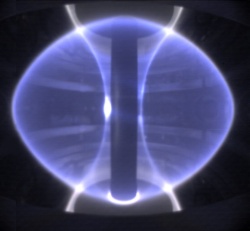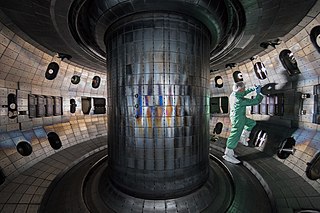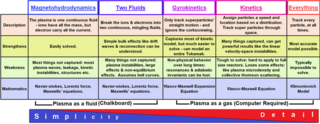Related Research Articles

Princeton Plasma Physics Laboratory (PPPL) is a United States Department of Energy national laboratory for plasma physics and nuclear fusion science. Its primary mission is research into and development of fusion as an energy source. It is known for the development of the stellarator and tokamak designs, along with numerous fundamental advances in plasma physics and the exploration of many other plasma confinement concepts.

Magnetic confinement fusion (MCF) is an approach to generate thermonuclear fusion power that uses magnetic fields to confine fusion fuel in the form of a plasma. Magnetic confinement is one of two major branches of controlled fusion research, along with inertial confinement fusion.

DIII-D is a tokamak that has been operated since the late 1980s by General Atomics (GA) in San Diego, California, for the United States Department of Energy. The DIII-D National Fusion Facility is part of the ongoing effort to achieve magnetically confined fusion. The mission of the DIII-D Research Program is to establish the scientific basis for the optimization of the tokamak approach to fusion energy production.

Marshall Nicholas Rosenbluth was an American plasma physicist and member of the National Academy of Sciences, and member of the American Philosophical Society. In 1997 he was awarded the National Medal of Science for discoveries in controlled thermonuclear fusion, contributions to plasma physics, and work in computational statistical mechanics. He was also a recipient of the E.O. Lawrence Prize (1964), the Albert Einstein Award (1967), the James Clerk Maxwell Prize for Plasma Physics (1976), the Enrico Fermi Award (1985), and the Hannes Alfvén Prize (2002).

Plasma modeling refers to solving equations of motion that describe the state of a plasma. It is generally coupled with Maxwell's equations for electromagnetic fields or Poisson's equation for electrostatic fields. There are several main types of plasma models: single particle, kinetic, fluid, hybrid kinetic/fluid, gyrokinetic and as system of many particles.
Gyrokinetic ElectroMagnetic (GEM) is a gyrokinetic plasma turbulence simulation that uses the particle-in-cell method. It is used to study waves, instabilities and nonlinear behavior of tokamak fusion plasmas. Information about GEM can be found at the GEM web page. There are two versions of GEM, one is a flux-tube version and the other one is a global general geometry version. Both versions of GEM use a field-aligned coordinate system. Ions are treated kinetically, but averaged over their gyro-obits and electrons are treated as drift-kinetic.
John Myrick Dawson was an American computational physicist and the father of plasma-based acceleration techniques. Dawson earned his degrees in physics from the University of Maryland, College Park: a B.S. in 1952 and Ph.D. in 1957. His thesis "Distortion of Atoms and Molecules in Dense Media" was prepared under the guidance of Zaka Slawsky.

Sir Steven Charles Cowley is a British theoretical physicist and international authority on nuclear fusion and astrophysical plasmas. He has served as director of the United States Department of Energy (DOE) Princeton Plasma Physics Laboratory (PPPL) since 1 July 2018. Previously he served as president of Corpus Christi College, Oxford, since October 2016. and head of the EURATOM / CCFE Fusion Association and chief executive officer of the United Kingdom Atomic Energy Authority (UKAEA). He was appointed chair of the board of trustees of the Faraday Institution in July 2024.
Norman Rostoker was a Canadian plasma physicist known for being a pioneer in developing clean plasma-based fusion energy. He co-founded TAE Technologies in 1998 and held 27 U.S. Patents on plasma-based fusion accelerators.

TJ-II is a flexible Heliac installed at Spain's National Fusion Laboratory.
Miklos Porkolab (born March 24, 1939) is a Hungarian-American physicist specializing in plasma physics.
Leonid Eremeyevich Zakharov is a Russian physicist who is a researcher at Princeton University. He attended Lomonosov Moscow State University (1965–1971). He was awarded the status of Fellow in the American Physical Society, after they were nominated by their Division of Plasma Physics in 2007, for "contributions to the theory and numerical calculation of magnetohydrodynamic equilibria, stability, and transport in toroidal plasma confinement devices and for innovative ideas concerning the development of a lithium walled tokamak as an approach to an economic reactor."
Tihiro Ohkawa was a Japanese physicist whose field of work was in plasma physics and fusion power. He was a pioneer in developing ways to generate electricity by nuclear fusion when he worked at General Atomics. Ohkawa died September 27, 2014, in La Jolla, California, at the age of 86.

Akira Hasegawa is a Japanese theoretical physicist and engineer who has worked in the U.S. and Japan. He is known for his work in the derivation of the Hasegawa–Mima equation, which describes fundamental plasma turbulence and the consequent generation of zonal flow that controls plasma diffusion. Hasegawa also made the discovery of optical solitons in glass fibers, a concept that is essential for high speed optical communications.
Keith Howard Burrell is an American plasma physicist.
Kunioki Mima is a Japanese plasma physicist. He is known for his contributions to the theory of turbulent transport in plasmas, and in particular the derivation of the Hasegawa–Mima equation in 1977, which won him the 2011 Hannes Alfvén Prize.
Patrick Henry Diamond is an American theoretical plasma physicist. He is currently a professor at the University of California, San Diego, and a director of the Fusion Theory Institute at the National Fusion Research Institute in Daejeon, South Korea, where the KSTAR Tokamak is operated.
Choong-Seock Chang is a South Korean physicist.
Linda Ellen Sugiyama is an American plasma physicist, a research affiliate in the High Energy Plasma Physics Group of the Laboratory for Nuclear Science at the Massachusetts Institute of Technology, where she earned her PhD in 1980 under the joint supervision of Chia-Chiao Lin and Bruno Coppi.
References
- ↑ "Belli, Emily Ann, 1977-", LC Name Authority File (LCNAF), Library of Congress, retrieved 2024-11-29
- ↑ Using ORNL's Frontier supercomputer, researchers discover new clues to improving fusion confinement, Oak Ridge National Laboratory, June 24, 2024, retrieved 2024-11-29
- 1 2 "Emily Belli", Lecturer biographies: 2nd Computational Physics School for Fusion Research, MIT Plasma Science and Fusion Center, 2021, retrieved 2024-11-29
- ↑ Staircase to the stars: Turbulence in fusion plasmas may not be all bad, Princeton University, October 16, 2019, retrieved 2024-11-29
- ↑ Belli, Emily Ann (2006), Studies of Numerical Algorithms for Gyrokinetics and the Effects of Shaping on Plasma Turbulence (PDF), Princeton University, Bibcode:2006PhDT........64B , retrieved 2024-11-29
- ↑ Graduate theses, Princeton Program in Plasma Physics, retrieved 2024-11-29
- ↑ APS Fellows archive, American Physical Society, retrieved 2024-11-29
- ↑ "Off and running", The Coast News, January 27, 2011, retrieved 2024-11-29; Results: 2011 Tri-City Medical Center Carlsbad Marathon , retrieved 2024-11-29; Local runner Emily Belli ran a personal best time, finishing second in the women's marathon, qualifying for the Olympic Trials at Sunday's race, Zuma Press, Inc. / Alamy Stock Photo, January 22, 2011, retrieved 2024-11-29
- ↑ "San Francisco Marathon 2011", MarathonView, retrieved 2024-11-29